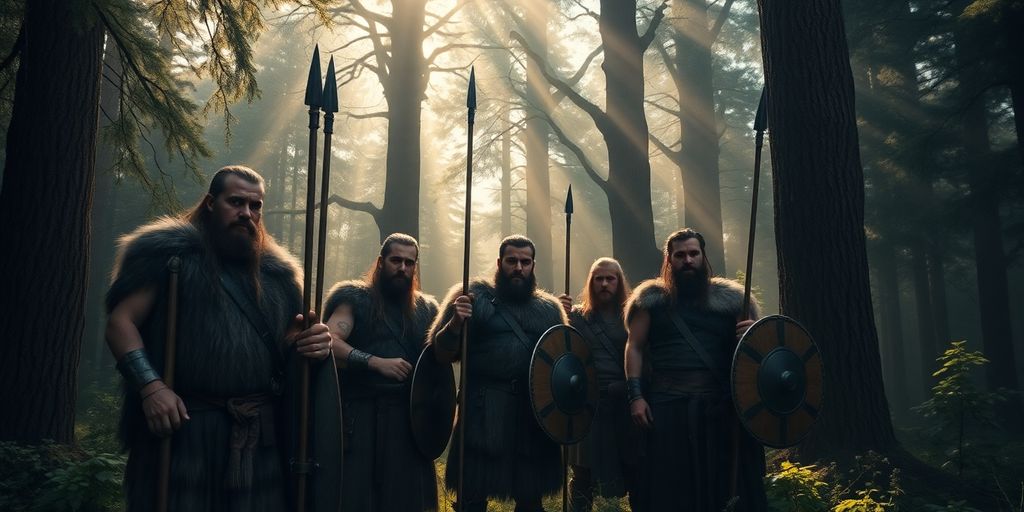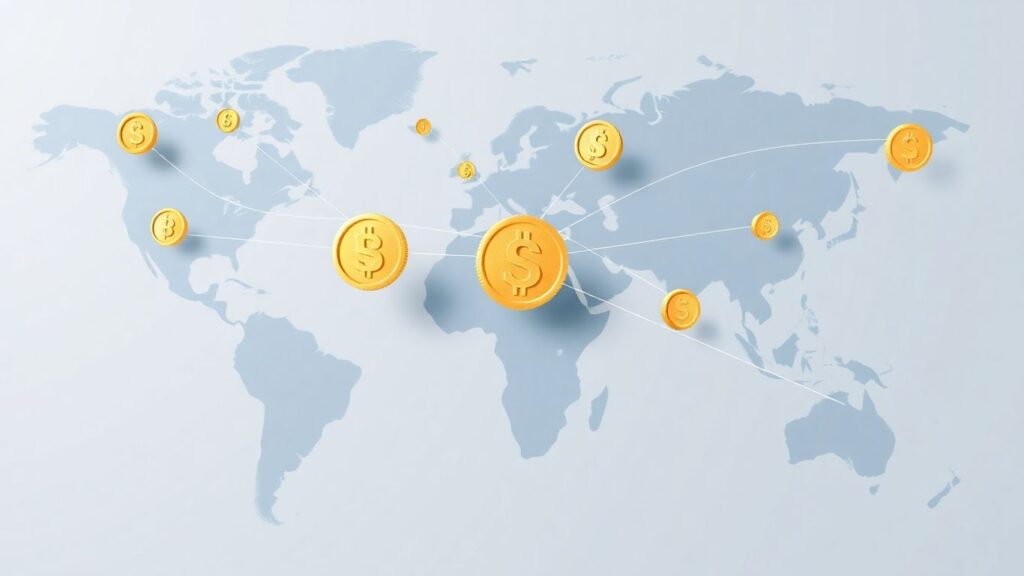Unraveling the Germanic People Origin: A Historical Journey

Ever wonder where the Germanic people came from? It’s a pretty long story, going way back before modern countries even existed. We’re talking about ancient tribes, big movements of people, and how they eventually shaped a huge part of Europe. Understanding their early days helps us get a better handle on the languages, cultures, and even some of the borders we see today. So, let’s take a look at the Germanic people origin and see how it all started.
Key Takeaways
- The Germanic people’s story starts with their Indo-European roots and how their unique language developed in northern Europe.
- Early Germanic tribes moved around a lot, eventually settling in different areas and forming distinct groups.
- Their interactions with the Roman Empire, like the famous Battle of the Teutoburg Forest, really changed history for both sides.
- Daily life for these early groups involved strong tribal bonds, farming, and a rich set of myths and beliefs.
- The large-scale migrations of Germanic tribes had a huge impact, leading to new kingdoms and forever changing the map of Europe.
Tracing the Germanic People Origin: Early Roots
Indo-European Ancestry and Proto-Germanic Development
Okay, so where did these Germanic people even come from? Well, it’s a long story that starts way back with the Indo-European language family. The Germanic languages are a branch of this massive family tree, which also includes stuff like Latin, Greek, and Sanskrit. Think of it like a family reunion where everyone speaks a slightly different version of the same ancient language. Over time, this Proto-Germanic language evolved, setting the stage for the later Germanic tongues we know today.
Archaeological Evidence of Early Germanic Settlements
Digging in the dirt is super important for figuring out the past. Archeologists have found a bunch of stuff that helps us understand where the early Germanic people lived and how they lived. We’re talking pottery, tools, weapons – the whole shebang. These finds give us clues about their daily lives, their technology, and even their beliefs. For example, the Jastorf culture is often linked to early Germanic groups, showing up in the archeological record with distinct burial practices and artifacts. It’s like a giant puzzle, and each little piece of pottery helps us put it together.
Geographic Origins in Northern Europe
So, where exactly did all this go down? The general consensus is that the Germanic people originated in Northern Europe. We’re talking Scandinavia and the northern part of what is now Germany. It’s a pretty harsh environment, which probably shaped their culture and way of life. They were tough cookies, that’s for sure. They gradually spread out from this area, moving south and east, eventually bumping heads with the Romans and other groups. It’s like they started in a small town and then decided to see the world, one migration at a time.
The early Germanic people weren’t just sitting around waiting for history to happen. They were actively shaping their own destiny, moving, adapting, and creating a unique culture that would eventually leave a huge mark on Europe. It’s a story of resilience, innovation, and a whole lot of walking.
The Emergence of Distinct Germanic Tribes
As Germanic populations expanded, they started to differentiate, leading to the rise of distinct tribal groups. This wasn’t a sudden split, but a gradual process influenced by geography, contact with other cultures, and internal developments. By the mid-first millennium BCE, several identifiable Germanic groups were emerging, each with its own unique characteristics.
Linguistic Diversification and Dialectal Groups
Language played a key role in shaping these tribal identities. As Germanic speakers spread out, their language began to evolve in different directions. This resulted in the formation of various dialects, which eventually solidified into distinct language branches. These linguistic differences contributed to the sense of separate identities among the tribes. Think of it like how American English and British English are different today, but on a much larger scale and with less communication between the groups.
Migration Patterns and Settlement Strategies
Migration was a constant factor in the development of Germanic tribes. As populations grew and resources became scarce, groups moved in search of new lands to settle. These migrations weren’t random; they followed certain patterns, often along rivers or through mountain passes. The settlement strategies employed by these tribes also varied, depending on the environment and the presence of other groups. Some tribes favored fortified settlements, while others preferred a more dispersed pattern of villages.
Distinguishing Western and Eastern Germanic Peoples
One of the most important distinctions among the Germanic tribes is the division between Western and Eastern groups. This division is based primarily on linguistic differences, but it also reflects cultural and historical differences.
- Western Germanic tribes, such as the Franks, Saxons, and Alemanni, settled in areas closer to the Rhine River and the North Sea.
- Eastern Germanic tribes, including the Goths, Vandals, and Burgundians, migrated further east and south, eventually coming into contact with the Roman Empire.
- These groups developed different social structures and belief systems.
The distinction between Western and Eastern Germanic tribes is not always clear-cut, and there was considerable interaction and exchange between the two groups. However, this division provides a useful framework for understanding the diversity of the Germanic world.
Germanic Peoples and Roman Encounters
Roman Documentation of Germanic Tribes
The Romans, ever the meticulous record-keepers, provide some of the earliest written accounts of the Germanic peoples. Think of guys like Julius Caesar and Tacitus. They weren’t exactly unbiased observers, of course. They often portrayed the Germanic tribes as barbaric and uncivilized, but also with a grudging respect for their fighting abilities. These accounts, while colored by Roman perspectives, offer valuable insights into the social structures, customs, and locations of various tribes. It’s like reading someone else’s diary – you get a glimpse, but you have to take it with a grain of salt.
The Battle of the Teutoburg Forest: A Defining Moment
The Battle of the Teutoburg Forest in 9 AD was a total game-changer. This is where Arminius, a Germanic chieftain who had actually served in the Roman army, led a coalition of tribes in a devastating ambush against three Roman legions. The Romans got completely wiped out. This defeat had a huge impact. It halted Roman expansion east of the Rhine River and pretty much established the Rhine as the border between the Roman Empire and Germania. It also became a symbol of Germanic resistance to Roman rule. It’s one of those events that shaped the course of history.
Impact on Roman Imperial Strategy
After the Teutoburg Forest disaster, the Romans shifted their strategy from outright conquest to a more defensive approach. They built fortifications and established a system of border defenses, like the Limes Germanicus, to control movement and prevent raids. They also tried to play different tribes against each other, using diplomacy and bribery to maintain a balance of power. The Romans realized that conquering Germania was just too costly and difficult, so they focused on containing the Germanic tribes and protecting their own territory. It was a pragmatic decision, but it also meant that the Germanic peoples remained independent and continued to develop their own distinct cultures.
The Roman-Germanic relationship was complex. It wasn’t just about war and conflict. There was also trade, cultural exchange, and even cooperation. Some Germanic tribes served as mercenaries in the Roman army, and Roman goods and ideas spread into Germanic territories. But ultimately, the relationship was defined by a struggle for power and control, and the Romans never fully succeeded in subduing the Germanic peoples.
Daily Life and Culture of Early Germanic Societies

Tribal Structures and Warrior Culture
Early Germanic societies were heavily structured around tribal affiliations. These tribes weren’t just loose groups; they were the core of social, political, and military life. The warrior culture was central, with young men trained from an early age in combat. Loyalty to the tribe and its leaders was paramount, and bravery in battle was highly valued. This emphasis on warfare shaped many aspects of their daily lives, from resource acquisition to social status.
Farming Practices and Economic Life
Agriculture formed the backbone of the Germanic economy. While not always advanced, their farming practices were essential for survival. They cultivated crops like barley, wheat, and rye, and animal husbandry was also important, with cattle, pigs, and sheep providing meat, milk, and wool. Economic life wasn’t solely agrarian; trade played a role, especially with neighboring Celtic and later Roman populations. The Germanic people periodically cleared forests to extend the range of their pasturage.
Here’s a simplified view of typical crops:
| Crop | Importance |
|---|---|
| Barley | Staple |
| Wheat | Common |
| Rye | Hardy |
Germanic Mythology and Pagan Beliefs
Germanic mythology was a complex system of beliefs centered around a pantheon of gods and goddesses. Figures like Wodan (Odin) and Thor were central, embodying war, wisdom, and strength. Rituals and sacrifices were performed to appease the gods and ensure good fortune. These beliefs influenced every aspect of life, from daily routines to major decisions. The I1d1 haplogroup may have influenced the spread of these beliefs through migration.
Germanic paganism wasn’t just a religion; it was a worldview that shaped their understanding of the world and their place in it. It provided explanations for natural phenomena, moral codes, and a sense of community. The myths and legends were passed down orally, preserving their cultural heritage through generations.
Here are some key aspects of their beliefs:
- Emphasis on fate and destiny.
- Belief in an afterlife, often linked to valor in battle.
- Respect for nature and its forces.
The Migration Period and Reshaping Europe

The 5th century was a time of HUGE change. The Western Roman Empire was losing its grip, and Germanic peoples, feeling the pressure from population growth and groups moving in from Asia, started moving en masse. They went everywhere – Britain, down through Europe, even to North Africa. It was a domino effect, with tribes pushing into each other’s territories, leading to wars and a scramble for land. Eventually, they started settling down, building permanent homes and expanding outwards under strong leaders. It was a wild time, and it completely changed the map of Europe.
Mass Movements of Germanic Tribes
It wasn’t just a simple case of people packing up and moving. These migrations were complex, multi-directional, and often involved conflict. Think of it like a giant game of musical chairs, but with land and power at stake. The Ostrogoths, Visigoths, and Lombards all made their way into Italy. The Vandals, Burgundians, Franks, and Visigoths carved out chunks of Gaul. The Vandals even made it to North Africa. All this movement had a ripple effect, altering the balance of power and setting the stage for the medieval world. The Migration Period was a time of great upheaval.
Conflict and Integration with Celtic Populations
It wasn’t all smooth sailing. As the Germanic tribes moved, they ran headfirst into the Celts. Some Celts were forced to adopt Germanic ways, while others moved on. There was definitely conflict, but also integration. The Germanic people periodically cleared forests to extend the range of their pasturage. It’s hard to say exactly how much mixing happened, but archaeological records show that the Germanic tribes are hard to distinguish from the Celts on many accounts.
Formation of Germanic Kingdoms
Out of all the chaos, new kingdoms started to emerge. These weren’t just random settlements; they were organized political entities with their own rulers, laws, and cultures. The Franks, for example, would eventually become a major power in Europe. These kingdoms laid the foundation for many of the countries we know today. The rise of the Franks is a great example of this process.
The establishment of these kingdoms marked a significant shift in the political landscape of Europe. They represented a departure from the centralized Roman rule and the beginning of a new era characterized by decentralized power and regional identities.
The Rise of Germanic Powers in the Early Middle Ages
The Franks and the Carolingian Empire
Okay, so the Franks. They started out as just another Germanic tribe, but they really got their act together. Under leaders like Clovis, they began gobbling up territory, and by the time Charlemagne came around, they were running a serious empire. It’s wild to think about how a relatively small group managed to become such a dominant force. They were based in what is now France and parts of Germany, and they were super important in shaping the political landscape of Europe. They were really good at war, and they also knew how to make alliances and build a strong kingdom.
Charlemagne’s Influence on Germanic Lands
Charlemagne, or Charles the Great, was a big deal. I mean, really big. He expanded the Frankish kingdom into a huge empire, and he was crowned "Emperor of the Romans" by the Pope in 800 AD. This was a symbolic moment because it kind of revived the idea of a Roman Empire in the West, but with a Germanic twist. He pushed for education and culture, trying to bring some order and learning to his lands. He also set up a system of governance that, while not perfect, helped to organize his vast territories. He left a lasting mark on the Germanic lands, and his legacy continued to shape the region for centuries.
The Holy Roman Empire: A Germanic Legacy
So, after Charlemagne’s empire fell apart, things got a bit messy. But eventually, out of the eastern part of his old empire, came the Holy Roman Empire. Now, this wasn’t really "holy," "Roman," or even much of an "empire" in the way we think of empires today. It was more like a collection of smaller states and territories, mostly in what is now Germany, with an elected emperor. It was a weird, decentralized thing, but it lasted for a really long time – all the way until 1806! It’s a key part of understanding German history, even if it was a bit of a chaotic mess. It’s a good example of how the Germanic people origin shaped the political landscape of Europe.
The Holy Roman Empire was a complex entity. It wasn’t a unified state like France or England. Instead, it was a collection of hundreds of smaller states, principalities, and free cities, all owing allegiance to the Emperor. This decentralized structure often led to internal conflicts and power struggles, but it also allowed for a degree of regional autonomy and cultural diversity.
Here’s a quick look at some key aspects:
- Decentralized structure
- Elected Emperor
- Lasted until 1806
Enduring Legacies of the Germanic People Origin
Linguistic Heritage in Modern German
Okay, so, you know how languages evolve? Well, the Germanic languages are no exception. Modern German, along with English, Dutch, and the Scandinavian languages, all trace back to Proto-Germanic. It’s kinda wild to think about how words and grammar have shifted over centuries. You can still see some similarities if you look closely, like how some basic words sound alike across different Germanic languages. It’s like a family reunion, but with words.
Cultural Echoes in Contemporary Society
Germanic culture didn’t just vanish, it’s still around, just, you know, different. Think about some of the traditions we have today. Some holidays, like Christmas, have roots in Germanic pagan celebrations. Even some of our ideas about law and governance can be traced back to early Germanic tribal customs. It’s not always obvious, but it’s there if you dig a little. It’s like finding an old family photo in the attic – a little faded, but still recognizable.
Historical Narratives of Identity and Resilience
The story of the Germanic people is one of constant change and adaptation. They moved, they fought, they built, and they left their mark on history. Their story is a reminder that identity is not fixed, but something that is always being shaped by events and interactions. It’s a story of survival, innovation, and the enduring human spirit.
Here are some key takeaways:
- The Germanic people weren’t just one big group, but many different tribes with their own stories.
- Their interactions with the Roman Empire had a huge impact on both sides.
- Their legacy lives on in language, culture, and the way we think about history.
Conclusion
So, we’ve gone through a lot, right? From those early tribes hanging out in northern Europe to the big empires that came later, the story of the Germanic people is pretty wild. It’s not just about old battles or dusty maps. It’s about how people moved around, mixed with others, and slowly built up what we now know as German culture. Think about it: the language, some traditions, even how different regions feel—a lot of that stuff has roots way back in time. It shows how tough and creative people were, always finding new ways to live and make their mark. This long history really shaped a big part of Europe, and you can still see bits of it everywhere if you know where to look.
Frequently Asked Questions
Who were the Germanic peoples?
The Germanic peoples were groups from northern Europe who spoke related languages. They played a huge role in shaping European history, especially during Roman times and the early Middle Ages.
Where did the Germanic peoples originally come from?
They most likely came from what is now Denmark and southern Scandinavia. As their groups grew, they spread out into other parts of Europe.
Did the Germanic peoples fight against the Roman Empire?
Yes, they did! A famous example is the Battle of the Teutoburg Forest in 9 AD, where Germanic tribes beat three Roman armies. This battle made Rome decide not to try and conquer more land in Germania.
What was daily life like for early Germanic societies?
Life was often about farming and living in tribes. They had a strong warrior culture and believed in many gods, which we now call Germanic mythology.
What was the Migration Period?
The Migration Period was when many Germanic tribes moved across Europe, especially after the Roman Empire started to weaken. These movements changed the map of Europe and led to the creation of new kingdoms.
How do the Germanic peoples still influence us today?
Their legacy is still very clear today. The German language comes directly from their ancient tongues. Many cultural traditions and even ideas about identity in modern Germany can be traced back to these early groups.








Responses